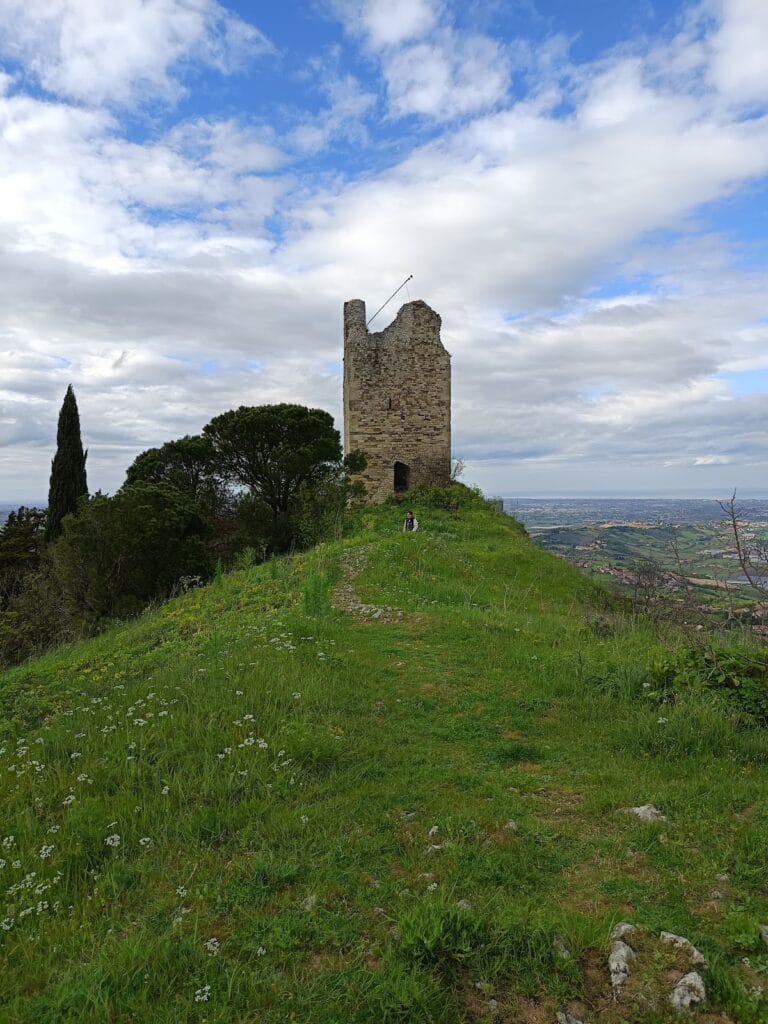Castello Due Torri di Scorticata: A Medieval Fortress in Poggio Torriana, Italy
Visitor Information
Google Rating: 4.6
Popularity: Low
Google Maps: View on Google Maps
Official Website: www.castelloduetorri.com
Country: Italy
Civilization: Medieval European
Remains: Military
History
Castello Due Torri di Scorticata stands within the municipality of Poggio Torriana, Italy, and was established by medieval inhabitants around the year 1000 as a fortified stronghold. From its earliest days, the castle played a role in controlling the surrounding territory on the hills near Verucchio.
The earliest known record of the castle dates to 1141, when Pope Lucius II transferred ownership to the church authorities in Rimini. In 1186, control shifted to the Malatesta family, a dynasty that held considerable influence in the region and used the castle as part of a network of defensive sites protecting their domains, including Verucchio, Fano, and Mondolfo. The Malatesta maintained their hold on the fortress until the mid-15th century.
In 1462, the castle fell to Federico da Montefeltro, the Duke of Urbino, who took it on behalf of the Church. This marked an important change in administration. The next century saw a brief Venetian occupation in the early 1500s, followed in 1519 by Pope Leo X granting the castle, along with nearby Verucchio, to lesser members of the Medici family. Afterward, ownership passed through several individuals: Ippolita Comnena, widow of Zanobi de’ Medici; then their son Alberto IV Pio di Savoia, until his death in 1580 when the fiefdom returned to the direct control of the Papal treasury, known as the Apostolic Camera.
Around 1608, administration of the castle was handed over to the Municipality of Rimini, by which time the site’s military importance was diminishing. Over subsequent decades, the slopes around the castle were subject to extensive quarrying for building stone and marble, which affected the surrounding landscape.
Local tradition links the castle with a dramatic event tied to the Malatesta family. It is said that this was the place where Paolo Malatesta’s sons avenged their uncle Gianciotto Malatesta, who had murdered his wife Francesca da Polenta and her lover. This story is famously recounted in Dante Alighieri’s Divine Comedy, linking the castle to enduring literary memory.
The castle’s name underwent two notable changes during the 20th century: it was referred to as “Castello di Torriana” in 1938 and later renamed “Castello Due Torri” in the 1960s, reflecting evolving local and historical identities.
Remains
The Castello Due Torri di Scorticata occupied two hilltops, with its defensive walls stretching approximately 1000 meters, enclosing an extensive fortified area. This layout indicates a significant military installation designed to control a broad area.
A description from 1371 by Cardinal Anglico recorded that the castle contained 35 rooms, though detailed information regarding the internal layout or specific functions of these spaces is lacking. There are no surviving inscriptions or decorative elements that have been documented at the site.
The materials used in construction and the precise architectural style are not detailed in available sources. Similarly, no archaeological evidence such as tools, pottery, altars, or other artifacts has been reported from excavations or surveys of the castle grounds.
The surrounding slopes have been heavily exploited for marble and stone over time, resulting in damage to the original landscape of the site. This quarrying has likely affected the preservation of features around the castle.
While the interior and many architectural details remain obscure, the castle’s extensive fortified walls reflect its historical role within the Malatesta defensive system. The proximity of this site to other Malatesta holdings, including Verucchio, highlights its strategic placement within the broader feudal territory once governed by this family.
No specific structures, gates, stairways, or mosaics have been formally described, nor have any restorations been recorded, leaving the ruins primarily characterized by their enclosing fortifications and their position within the landscape. The castle thus remains an archaeological testament to medieval fortification practices in the Rimini area, with its exact features awaiting further detailed study.







